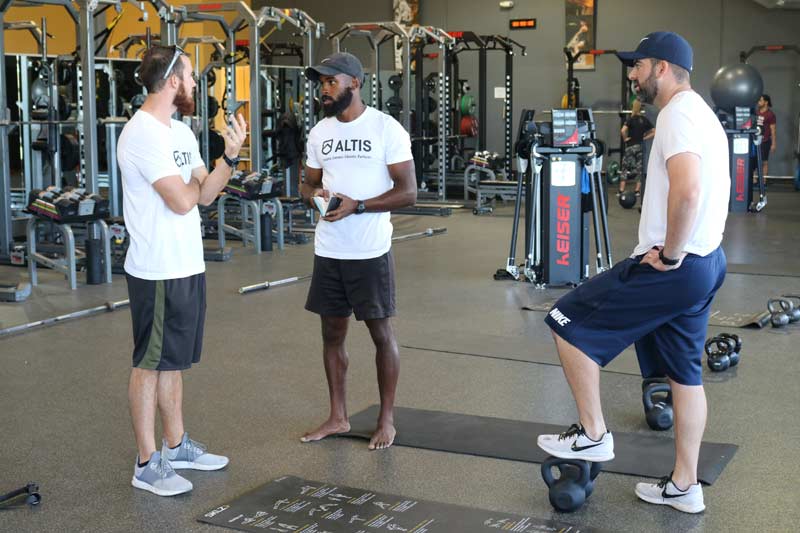

My friend John Berardi is spending much of the winter down here in Scottsdale, AZ, escaping the cold and snow of Ontario, Canada. If you don’t know JB, he is the founder of Precision Nutrition, the world’s largest online nutritional education and coaching company. I want to share with you something that JB and I have discussed numerous times over the years—the importance of accurately identifying the problem at hand.
Sounds easy, right?
It’s not.
In JB’s case, those invested in the world of nutrition were attempting to solve the problem of getting people to eat better. For decades, the industry identified the root of that problem as a lack of information. If only folks knew what to eat, or the timing of what they should eat, or how they should eat, they would begin to eat better. It was totally logical.
The issue with that solution, though, was that it just wasn’t working. They were “solving” the problem with education and information, but had not properly identified the real problem at hand: getting people healthier. Folks knew the difference between apples and apple pie, but still reached for the apple pie.
To JB, then, this was not an information problem—it was an application problem. Simply put, for a decade, the nutrition industry was simply trying to solve the wrong problem. By redefining it, however, JB was able to draw from a whole new set of potential solutions—ones that have served as the foundations for an amazing company, with success rates of almost double the industry standard.
A Paradigm Shift
What JB found was that the current paradigm in the industry of nutritional health was no longer able to solve the problems facing it. The common solutions to the problem he—and the nutritional industry as a whole—was trying to answer were no longer working.
They had reached a point of diminishing returns.
In effect, additional progress was constrained by the paradigm in which he was operating. Just as Copernicus’ heliocentrism changed how we thought about a multitude of scientific concepts, JB’s assertion that nutritional issues were not an information problem, but an application problem, changed how nutritionists approached their work.
JB’s example of redefining a problem has been described by Thomas Kuhn as the way in which science works. The crux of Kuhn’s work was the concept of a paradigm.
Contrary to the traditional idea at the time that knowledge is gained through an accumulation of facts and theories, Kuhn proposed that it advances through anomalies—paradigm shifts, or points in time where the current way of thinking could not account for certain phenomena.
Simply put, Kuhn thought that science advances through people being wrong.
If you’ve been struggling with a problem for years, is it possible that you’ve just been trying to solve the wrong problem, asks @StuMcMillan1. Share on XSo my question to you is this: How many of the problems that we encounter each day need redefining? Rather than continuing to bang our heads against the proverbial walls of a problem that we have struggled with for years, is it possible that we have just been trying to solve the wrong problem in the first place?
When have you been wrong and used this opportunity to springboard into a totally new way of looking at things—a totally new paradigm?
Problems of Chaos and Context
Working in sport is a uniquely social vocation, defined primarily through interaction and human management. More than the regurgitation of facts, it is about identifying problems and understanding how to effectively integrate solutions into our own unique environments. It is chaotic and contextual.
The challenge, though, is how do you teach chaos and context? It is far more than simply saying that coaching or therapy (or any other profession) is multidisciplinary or interdisciplinary, and leaving it there. It is one thing to appreciate the multidisciplinary nature of work in health and performance; it is another entirely to understand how we go about learning and applying any multidisciplinary knowledge.
This has been a 40-year quest for Coach Dan Pfaff, and has become my own obsession over the last 15 years of my career. For Dan—and for many others—it begins with an accurate definition of the problem, and working back from there.
Perhaps you have read some of the work of Professor Robyn Jones (from Cardiff Metropolitan University)? If not, I would highly recommend you check it out—it is interesting reading for all who work in sport. Professor Jones and his colleagues specifically discuss the chaotic, multidisciplinary nature of coaching, as well as the importance of interdisciplinary teams and how problem-based learning (PBL) addresses the challenges that result from the integrated, fluid nature of our work in sport.

To me, a big part of the problem is that many of us go through our lives outsourcing our thoughts. We allow others to do our thinking for us; and we generally don’t do the work required to think for ourselves. Because it is next to impossible for us to have a thorough understanding of all things necessary to navigate our worlds, we tend to respond instinctively, trusting the leaders of our chosen groups to think for us. And this is fine—up to a point.
This can work when we can trust our leaders. It does not when we do not. We find comfort and ease when being told what to do, what to say, and what to think. All of us are susceptible to this, and all of us no doubt go through periods when we are more and less susceptible.
Think about how we do this currently in our coaching or therapy practice…
How many ideas of others do we blindly copy, without the requisite understanding of the context from which those ideas stemmed?
An example in the coaching world can be found in how many S&C coaches copy the systems—often to the most minute detail—of well-known coaches. They do this despite working with entirely different populations, in an entirely different time, with an entirely different set of constraints.
We can be influenced by these systems, but to simply copy is folly. We know this intuitively, yet so many of us still do it. Rather than doing the work to fully understand the depth of our own problems, we too often begin with others’ “solutions,” and assume that an indiscriminate amalgamation of them will lead to a solution of our own.
How many young therapists blindly copy the step-by-step guides that have been put together by guru therapists (who are really only interested in selling their latest 10-week course)? Go on Instagram right now and look at the comments section of the latest exercise offering of today’s favorite guru coach or therapist. This is what you will see:
“Oh—that looks great. I’m tryin’ that tomorrow!”
“Love it! Gonna try this!”
“Stealing this one!”
This type of blind, non-critical response just serves to perpetuate the current system of poorly delivered and poorly understood information. Rather than blindly copying the flavor of the month, or the concepts of coaches and therapists from previous decades, we need to appreciate these ideas in context to get the whole story.

To do this, we need to dig deeper and ask the contextual questions, such as:
- What specific problems were being addressed?
- Where did the coach-therapist-methodologist get their information?
- What population was the coach-therapist-methodologist working with?
- What were the personality traits of the coach-therapist-methodologist?
- What experiences did the coach-therapist-methodologist have previous to teaching their methodology, system, or technique?
Considering Context vs. Content
Too often, we argue about the content of a thing, rather than the context. For an example, let’s talk about everyone’s favorite controversial topic: hamstrings.
There is a constant, ongoing—and seemingly intensifying—debate over the functionality (or whatever other word you want to insert here) of the Nordic hamstring exercise (NHE). People argue about the rotational velocity, the assumed lack of transference, the single-joint nature of the exercise, the DOMS, etc. But people are simply arguing about the wrong thing—they are debating the content rather than the context.
The content is ever-changing, depending upon time and circumstance—it is the what. The context is the meaning, the intent—it is the why, when, and where.
Much of the research around the efficacy of the NHE is centered around how this exercise has a positive effect on fascicle length, which has been shown to decrease the incidence of hamstring injury. Nordics are the content. In this example, an increase in fascicle length is the context. One might infer the content of something from its context, but not vice versa. Content is information, context is knowledge.
If we can better differentiate content from context, we can more accurately identify the problem in the first place, says @StuartMcMillan1. Share on XI’ll provide another example. One question that came up during last week’s ALTIS Apprentice Coach Program was what does the ALTIS staff think about single-leg Olympic lifts?
As I described then, in my opinion, this is the wrong question. The real question is about the context, not about the content.
Starting with the unique circumstances around your specific training environment, before talking about the content—the end result—we must answer the following questions:
- What is your objective?
- What are you trying to do?
- What are you trying to develop?
- Why are you even in the weight room in the first place?
If the reason that we program weight training is only for the development of specific strength abilities (max strength, speed strength, RFD, etc.), then it’s quite easy—all we do is select the exercises that are most appropriate to develop the strength ability that we’re trying to develop. And if this is our assertion, then yes, single-leg Olympic lifts are probably not appropriate.
If, however, you lift weights for other reasons—if you have other justifications for going into the weight room and if you feel there are things that you can get from lifting weights that are independent from the development of the strength abilities—then perhaps your answer is different. For example, if you leave any room at all in your training philosophy for the efficacy of any of what Frans Bosch talks about (i.e., the coordination justification), then this may change your answer vis-à-vis the single-leg cleans, and in this case, they might be totally appropriate.
The bottom line is you have to start from context—not content.
If we can better differentiate content from context, we can more accurately identify the problem in the first place. Content is transient—it is entirely dependent upon time and circumstance. Alone, content tells us very little. But, if we understand the context within which it exists, we have a starting place from which we can accurately identify the problem.
The digital ALTIS Performance Therapy Course goes further into the identification and management of problems. Download an introductory e-book to learn more!
Since you’re here…
…we have a small favor to ask. More people are reading SimpliFaster than ever, and each week we bring you compelling content from coaches, sport scientists, and physiotherapists who are devoted to building better athletes. Please take a moment to share the articles on social media, engage the authors with questions and comments below, and link to articles when appropriate if you have a blog or participate on forums of related topics. — SF


La incorporación de la ciencia, de manera constante a los problemas del Deporte, es la vía más expedita para su resolución. El aporte paradigmático, en términos de la redefinición trae en alza su valor, para ver con otros ojos el contexto y sus avances.
Google Translation: The incorporation of science, constantly to the problems of Sport, is the most expeditious way to solve them. The paradigmatic contribution, in terms of redefinition, brings its value to the fore, to see the context and its progress with different eyes.